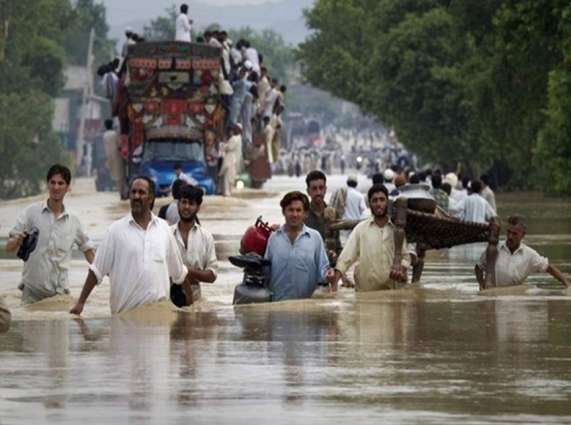Pakistan continues to suffer from massive flooding every year for not devising an effective strategy to address the issue of climate change as recent floods in 2022 have created havoc in the 2/3 area of the country.
By Syeda Ayesha Ashraf
A series of floods gradually increased by every passing year due to climate change badly affected the peoples’ lives in Pakistan. The natural disasters, one after another, caused huge damage to the country. In 2005, earthquake of 7.6 magnitudes shook the foundations of the country. Later, a series of floods which started from 2010 also continued in the following years of 2011, 12, 13 and 2014. Lots of people lost their lives in the rural areas while many others who lived could not find proper shelter.
The statistics show that over 2000 peoples were affected by 2010 floods and more than 20 million people faced serious economic loss the same year while the GDP growth went down and exports also fell about 60%.
The data shows that Pakistan bore loss of 2.5 million tons of Rice crop, sugarcane loss was 7.5-million-ton and there was over 0.7 million tons of cotton and maize crops loss. The 2011 floods in Gilgit Baltistan region damaged more than hundred houses and crop areas, whereas In 2012, about 14,270 rural districts and 1.1-million-acre crop was affected by the floods due to monsoon rain. The2013 floods damaged almost 80,000 houses and 1.5 million cash crops. Pakistan again faced several floods in 2014 in the monsoon season as the flow of water was quite high in Chenab River that subsequently affected Punjab. Besides this, massive land sliding in Gilgit Baltistan, Azad Jammu & Kashmir also caused damage to the economy.
A study conducted by Jingdong, et al proved that about 2.5million people were affected by rains, 367 people lost their lives while 129,880 houses got damage in September 2014. Their study showed that approximately 1.0 million acres of agriculture got affected and the farmers lost their crops and houses. The study showed that 2014 floods caused huge devastation in Punjab, GB and Azad Jammu and Kashmir. Small businesses, small home-based industries, service sector also got affected by the floods and the country witnessed sharp increase in unemployment.
The recent floods of 2022 have created havoc in the 2/3 area of the country, damaging villages and small towns in Balochistan and Sindh. Caused by heavy rainfall and melting glaciers, the last year floods were out of control. The infrastructure was completed damaged by the floods and diseases started surfacing in the affected areas. The women and the children suffered the most as the health facilities had been washed away by the floods in 2022. The pregnant women faced huge problems because there had been no health centre for their proper check-up in the affected areas.
The research conducted by Penning, Rowsell and Fordham (1994) established that the floods bring numerous societal problems as they damage the physical infrastructure and cause diseases. While Akbar et al. (2002) highlighted the unequal distribution of resources among affected communities, pointing out that those people who had low income or jobless face more impact of the floods. The laborers, he argued, suffered more while the powerful people enjoy more social assistance as they hold top position in the society and control the resources. In difficult times like floods, they do not suffer as much as the low-income people suffer.
It is climate change that has been affecting the lives of the citizens in Pakistan. The bitter fact is that Pakistan has emerged as the most vulnerable country to the climate change in the world. The study showed that around about 1290 persons died due to monsoon rains floods while 1,468,019 homes got damaged besides loss of 736,459 livestock. The mental health issues also surfaced in the country after the floods’ devastation. The facilities and treatment provided to the citizens were inadequate because there were thousands of affected people.
In order to decrease the consequences of flood disasters, there is a need to forecast monsoon rains as earlier as possible and promote awareness among the people through social media for the safe evacuation of flood affected areas before massive destruction.
Due to poor health facilities, there is also need for stocking medication related to water borne diseases. The authorities should establish rehabilitation centers for treatment of anxiety and stress related issues by trained psychologists. The mental health issues need a special attention in flood areas to treat flood victims and for this purpose; a medical response team should be trained now for the emergency response in such areas.
Government buildings like community centers, schools, and halls could be used as short-term shelters to avoid difficulties to the affectees. The other important thing is construction of dams as they can prevent Pakistan from massive flooding in future while learning from past experiences of flooding could be helpful to save the lives of the people and economy of the country.
The measures are needed to be taken immediately to address the issues of environmental threats, climate change and global warming.
Pakistan survived back-to-back natural disasters but the problem occurs when the human beings collide with the nature or disturb the nature balance for their own benefit. The state authorities, therefore, need to chalk out an effective and comprehensive strategy by building dams, clearing areas nearby the rivers and establishing forecasting system for monsoon season to save the people and the economy.




